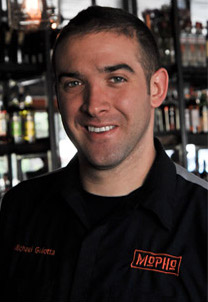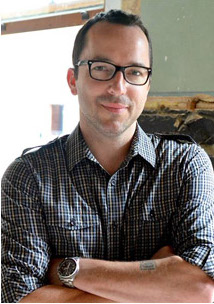
The guidance and training a chef receives within the kitchen – particularly during those early years – often dictates the tone of his or her career, from knife skills and spices to business acumen and demeanor. Whether cookbooks or creative bios, it is always referenced where a chef has worked previously, ripples that continue to flow for years to come. When a chef begins achieving great success, it’s exciting to see the evolution, the next generation of creativity emerging from great kitchens and trainings, ready to build expand on new restaurant dreams.
New Orleans’ Steven McHugh and Michael Gulotta are the next kitchen generation up to bat. Embarking recently on restaurants of their own – in San Antonio, Texas, and New Orleans, Louisiana, respectively – McHugh and Gulotta have taken their experiences and applied it to two uniquely different restaurant concepts.
I first met with Chef McHugh in 2010 shortly after he arrived in Texas to open Lüke San Antonio, while Gulotta was at the helm at Restaurant August when I dined in New Orleans in 2012.
Q: The last time we spoke, you were both working at Restaurant August in New Orleans. What was that experience like for you?

SM: On the cooking side, the philosophy we followed was always “it can be better” and “give them more” and that’s something that has stuck with me for life.
MG: I worked for Restaurant August from 2002 ’til 2013. It was such an intense experience because I was nurtured and encouraged to learn but also frequently pushed outside of my comfort zone. It was a great place to cut your teeth because it wasn’t like a typical flagship restaurant: it was expected that the P&Ls be in line and that the restaurant to be taking care of itself. I had to run proper food and labor costs while using as many local products as possible in addition to pounds upon pounds of ‘grade A’ foie gras and fresh truffles.
One of the most important lessons I learned from is that no matter where you are, be it in your own kitchen or halfway across the country, you always comport yourself in a gracious and professional manner, even if one of your boxes of food was lost in transit and the host kitchen’s oven just stopped working five minutes before the dinner is set to begin.
Q: Tell me about your respective restaurants. What was your inspiration in creating the space and cuisine that you have?
SM: When developing Cured, my wife Sylvia, and I wanted to create a restaurant where we would want to eat. We took inspiration from our travels, the places we’ve visited, the places we’ve lived, the food we love, and brought that all together. I grew up on a farm in Wisconsin, which inspired the farmhouse fare at Cured. The concept of farm-to-table was never even a “concept” for me – it was how I ate every day growing up – it was just a part of daily life. So it was a natural progression to make my menu one that is locally-sourced, smart, sustainable and seasonal.
My belief has always been to let the inherent qualities and purity of ingredients come first – to accentuate without overpowering them. That translates to the way I go about food and the way I went about restoring Cured’s historic space. We worked around its original accents, used old bricks to make a wine rack, brought in reclaimed floors from an old tobacco warehouse.
MG: MOPHO is the restaurant that I want to go to on my day off. The menu is approachable, but with bold flavors and local ingredients, the atmosphere is both casual and upbeat and the service still retains a sense of genuine southern hospitality. More than anything I want our guests to let their guard down and have fun. Too many people make dining stressful these days, they feel like they have to test the waiter or stump the bartender or be able to identify everything on the menu.
Q: Let’s talk numbers. Seats, staff?
SM: There are 142 seats total including the 12 seats at the charcuterie bar, 12 seats at the chefs bar, and 24 seats on the patio. There are about 55 on staff.
MG: We have about 82 seats inside and another 35 outside on the deck. Our crew is substantial at the moment, but our opening numbers have been surprisingly, and thankfully large, so we’ve been hiring to keep up.
Q: How about the wine and cocktail programs?
SM: For us, the most important consideration when we developed our wine and cocktail program was to make sure it fit our food and price point. We wanted to avoid having a wine list that was so exorbitant that people wouldn’t be able to afford it. We like to work with local producers, so with our wine list we were careful to seek out select wines that came from small wine houses. For beer, we put together a list of American crafts and throwback beers, like Pabst Blue Ribbon. Our cocktail program in a nutshell is pretty much “drinks for grownups.” We wanted to get back to the basics.
MG: The craft cocktail program at MOPHO features boozy bubble teas – or as we call them Vietnamese frozen daiquiris (another New Orleans creation that has nothing to do with the original cocktail) – along with a small but extensive selection of wines paired with our style of food. We also keep six local craft beers on draft since we find beer is a great compliment to our spicier food.
Q: What about your respective cities defines them as great food cities?
SM: San Antonio is a great city for food because of the people. There are thousands of people who come here for other reasons – industry, military, startups – so they arrive with seasoned palates and they expect and demand great food. San Antonio is a unique place – it’s a small town in a very big space. Everyone here knows and supports one another, which is why opening Cured here was so important – it’s our way to be involved and support the community. And we really appreciate the support.
MG: New Orleans is a great food city for multiple reasons. We have a long growing season for produce and we are surrounded by some of the most fertile fisheries in the country. We are a port city and melting pot and we celebrate our many cultures through local festivals. We are a festival city (I don’t like referring to us a party city) and all of these celebrations are food focused. We are fanatical about our food traditions.
I believe what is working for MOPHO is the fact that we opened in a neighborhood that is densely populated, centrally located and itching for a lighthearted alternative that is still serious about its food, drink and service. We offer a menu that is rooted in New Orleans tradition, so it is identifiable, but is lightened by using the Southeast Asian approach. New Orleans food is always full-on delicious but it can be heavy, and the number one comment we hear from our guests is that the food is so light and flavorful that they don’t feel ashamed to come here a few times a week.
We’ve also kept our interior upbeat and light as well with lots of windows and two large garage doors that open onto a deck. We made sure we had an extra long bar to keep people imbibing and the music is a mix of the staff’s favorite stations.
~Jennifer Heigl
*Photo credit: Steven McHugh/Cured; Michael Gulotta/MOPHO
